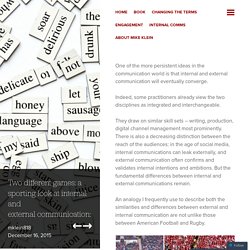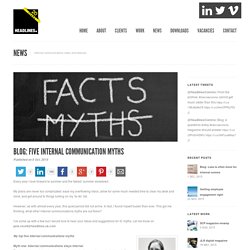

What A Botched Cobb Salad Teaches About Internal Communications. Last year I went to a conference at a hotel I won’t mention.

With just 20 minutes for lunch, I opted for the hotel restaurant, ordered a Cobb salad — no meat, extra cheese — and explained I was pressed for time. A few minutes later, I saw a salad emerge from the kitchen and then retreat. Then the same thing happened a second time. Time was running out, so I asked the waiter what was going on. He’d said he told the kitchen, “no meat,” but they didn’t listen. Let’s say, conservatively that this kind of misunderstanding — and comped meal — happens three times a day. To engage effectively with those who are most critical to your success, your team has to understand why your enterprise matters and how important it is to communicate that value in everything they do. 6 rookie mistakes made by internal communicators.
By Sarah Perry, CEO of SnapComms There’s a lot of pressure to get internal communications (IC) right.

Even more so these days, when “too much information” is choking employees’ inboxes. Whether you’re a newcomer to IC, or a seasoned pro, it’s imperative to avoid these six common fails when communicating with your teams: For a Limited Time receive a FREE HR Report "Top 10 Strategic HR Trends for the New Era. " This exclusive special report highlights recent changes in the HR profession, strategies for branding and recruiting, trends in performance management, tips for keeping high-potential employees engaged, and advice for using diversity and inclusion as a business strategy. 1. AKA “covering your backside.” Everyone you ask will have an opinion—and not all will be helpful. So be selective who you ask for editorial feedback and approval. 2. Think of your IC as the company newsroom, and you’re Chief Editor. 3.
Not only are you the curator of internal content, you’re the conductor too. Information overload causing major headache for IC professionals [video] ‘Noise, noise, and more noise’ - That’s the biggest headache facing Internal Communication (IC) experts today according to delegates at the IABC World Conference (International Association of Business Communicators), June 2016, New Orleans.
![Information overload causing major headache for IC professionals [video]](http://cdn.pearltrees.com/s/pic/th/information-professionals-133719289)
SnapComms interviewed several IC experts to hear first-hand about their biggest challenge, and the ubiquitous problem of employees not listening, aka information overload. Sarah Perry, CEO at SnapComms, summarises their comments: “Key company messages are getting drowned out. Why internal communications are just as important as external marketing. When most companies think about their communications, there is a temptation to focus on the external at the expense of the internal.

Marketing is of course, an effective way of spreading your company’s message and brand, but this will always be limited if you haven’t first conveyed the same ideals to your employees. Read more: Four simple steps to improved cybersecurity communication Security, for example, requires staff members to have a thorough understanding of company protocols. Technical efforts to safeguard your data will be rendered largely useless if you don’t have a clear way of informing employees about these are implemented.
However, it is not just about getting the information out there. Internal communication's Periodic Table of essential elements. Imagine the fundaments of your in-house messaging laid out like Mendelev's iconic chart.

Actually, you don't have to imagine that; it's already been done—with space for your additions. By Chuck Gose | Posted: December 8, 2015 In 1869, Dmitri Mendelev created the first-ever Periodic Table of Elements. Since then, Mendelev's design has evolved into the Periodic Table we know today—an arrangement of all known elements on Earth. Taking you back to high school science class, the table is organized by elements that have similar characteristics and arranges them in groups and families. Mendelev had the foresight and knowledge to know that his concept wasn't final: He included all the elements known at that time.
Countdown to Christmas: Day 16. Countdown to Christmas: Day 16 What’s the uncanny link between Finding Nemo and internal communication?

Not a question I’ve ever asked! But today’s brand new guest post, which is Day 16 of my Countdown to Christmas, aims to answer it. This article was written by Sarah Perry, (pictured), CEO of SnapComms. Internal communication for business success from the inside out. A few years ago, I was asked to speak to a college class on internal communication and I wanted it to be compelling.

I wanted to open their eyes to the excitement of internal communication helping an organization achieve its goals. So I decided to create a more impactful, memorable explanation of what I love to do every day and share my conviction that we can make a bigger difference from inside an organization. Internal communication has to be more than writing the newsletters and updating an intranet; it needs to affect business outcomes and engage employees. I sat down and began the task of trying to explain our role beyond the tactics. The result was a group of “i” words: Implement, Interact, Integrate, Influence and Impact. Interact: Relationships are another asset that internal communicators bring to the table. Integrate: Internal communicators have to understand the big picture but also must have insight into the individual programs/tactics implemented by a variety of departments. Two different games: a sporting look at internal and external communication:
One of the more persistent ideas in the communication world is that internal and external communication will eventually converge.

Indeed, some practitioners already view the two disciplines as integrated and interchangeable. They draw on similar skill sets – writing, production, digital channel management most prominently. There is also a decreasing distinction between the reach of the audiences: in the age of social media, internal communications can leak externally, and external communication often confirms and validates internal intentions and ambitions. But the fundamental differences between internal and external communications remain. Five internal communication myths. Every year I look forward to summer and the fabled ‘summer slowdown’.

My plans are never too complicated: ease my overflowing inbox, allow for some much needed time to clear my desk and mind, and get around to things lurking on my ‘to-do’ list. However, as with almost every year, this quiet period did not arrive. In fact, I found myself busier than ever. Advantages of Internal Communication. Differences between Internal and External Communication. Internal communication glossary. The search terms people use to get to the All Things IC blog reveal readers are looking for definitions to help them understand all things internal communication related.

What is internal communication? What does ‘copy’ mean and what does ESN stand for? You’re in the right place to find out. This page aims to demystify and unlock some of the phrases and acronyms commonly associated with the profession. Many are Rachel’s own explanations, some are the most-common descriptions or references are cited. Rules of Internal Communication - Communication World. By Liam FitzPatrick and Klavs Valskov Talking to your workforce involves almost every skill set in the communication profession and a few that are unique to employee communication.
Writing, event management, message planning, design and advising leaders have to supplement an understanding of line supervisors and coping with the darker corners of HR. We recently sat down to write a book explaining the practice of internal communication, to produce the guide that we wish we’d been given when we started working in the field. Internal communication and employee engagement by Rachel Miller.
What is internal communication? Characteristics of Internal Communication. What is Internal Communication? I got a strange look. The question was asked during an interview for a role that I had applied for. It was a fair question and something I think interviewers should be asking of potential new employees for internal communication roles. The problem, I don’t think they got the answer. In fact I know they didn’t get the answer, as the feedback I got after the interview stated I didn’t show enough understanding of the principle and process of internal communications.
Hhmm. Maybe the above statement is too simply. Communicative ability – Not all organisations are set up to communicate effectively. Engaged employees – Now this is my hobby-horse at the moment – employee engagement. Goal directed – Communication must be goal-directed, that is, it must achieve an outcome, change a behaviour, achieve a vision, etc.